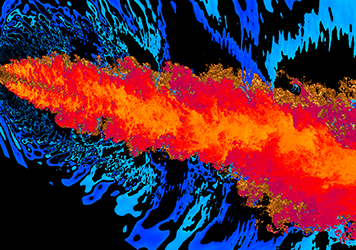 The ASCR Leadership Computing Challenge projects that make up roughly 30% of the time awarded on ALCF supercomputers each year go to support “high-risk, high-payoff” simulations of interest to the DOE. Stanford’s Parviz Moin used his 60 million hour award to make a new and potentially industry-changing discovery about the source of supersonic jet noise. No ear protection needed.
The ASCR Leadership Computing Challenge projects that make up roughly 30% of the time awarded on ALCF supercomputers each year go to support “high-risk, high-payoff” simulations of interest to the DOE. Stanford’s Parviz Moin used his 60 million hour award to make a new and potentially industry-changing discovery about the source of supersonic jet noise. No ear protection needed.
Moin and his team ran large eddy simulations on Intrepid to determine the source of crackle in hot supersonic jet engines. Crackle is a major source of engine noise that causes hearing damage and impacts fuel efficiency. This particularly irritating phenomenon is associated with shock-like “N-shaped” acoustic waveforms consisting of sudden strong compressions followed by more gradual expansions. Because crackle occurs in the direction of peak jet noise, its elimination has the potential to help meet the U.S. Navy’s near-term jet noise reduction goal of 3 dB in the peak noise.
One way to make jets less noisy is to modify the shapes of the engine exhaust nozzles using pointed cutouts, called chevrons. Past ALCF allocations to Moin enabled a comprehensive study of the physical mechanisms by which chevrons affect the jet mixing and shock-associated noise. His current allocation was used to complete the simulations capturing crackle events and to develop new methods to identify and save such events for further study. Furthermore, with the source of the crackle noise now identified, new nozzle designs can be simulated.
Categories
Cracking the source of crackle in supersonic jet noise
